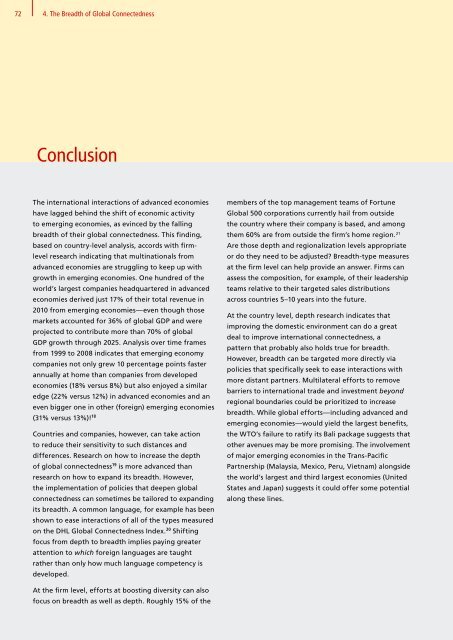DHL Global Connectedness Index 2014
DHL Global Connectedness Index 2014
DHL Global Connectedness Index 2014
- No tags were found...
Create successful ePaper yourself
Turn your PDF publications into a flip-book with our unique Google optimized e-Paper software.
72 4. The Breadth of <strong>Global</strong> <strong>Connectedness</strong><br />
Conclusion<br />
The international interactions of advanced economies<br />
have lagged behind the shift of economic activity<br />
to emerging economies, as evinced by the falling<br />
breadth of their global connectedness. This finding,<br />
based on country-level analysis, accords with firmlevel<br />
research indicating that multinationals from<br />
advanced economies are struggling to keep up with<br />
growth in emerging economies. One hundred of the<br />
world’s largest companies headquartered in advanced<br />
economies derived just 17% of their total revenue in<br />
2010 from emerging economies—even though those<br />
markets accounted for 36% of global GDP and were<br />
projected to contribute more than 70% of global<br />
GDP growth through 2025. Analysis over time frames<br />
from 1999 to 2008 indicates that emerging economy<br />
companies not only grew 10 percentage points faster<br />
annually at home than companies from developed<br />
economies (18% versus 8%) but also enjoyed a similar<br />
edge (22% versus 12%) in advanced economies and an<br />
even bigger one in other (foreign) emerging economies<br />
(31% versus 13%)! 18<br />
Countries and companies, however, can take action<br />
to reduce their sensitivity to such distances and<br />
differences. Research on how to increase the depth<br />
of global connectedness 19 is more advanced than<br />
research on how to expand its breadth. However,<br />
the implementation of policies that deepen global<br />
connectedness can sometimes be tailored to expanding<br />
its breadth. A common language, for example has been<br />
shown to ease interactions of all of the types measured<br />
on the <strong>DHL</strong> <strong>Global</strong> <strong>Connectedness</strong> <strong>Index</strong>. 20 Shifting<br />
focus from depth to breadth implies paying greater<br />
attention to which foreign languages are taught<br />
rather than only how much language competency is<br />
developed.<br />
members of the top management teams of Fortune<br />
<strong>Global</strong> 500 corporations currently hail from outside<br />
the country where their company is based, and among<br />
them 60% are from outside the firm’s home region. 21<br />
Are those depth and regionalization levels appropriate<br />
or do they need to be adjusted Breadth-type measures<br />
at the firm level can help provide an answer. Firms can<br />
assess the composition, for example, of their leadership<br />
teams relative to their targeted sales distributions<br />
across countries 5–10 years into the future.<br />
At the country level, depth research indicates that<br />
improving the domestic environment can do a great<br />
deal to improve international connectedness, a<br />
pattern that probably also holds true for breadth.<br />
However, breadth can be targeted more directly via<br />
policies that specifically seek to ease interactions with<br />
more distant partners. Multilateral efforts to remove<br />
barriers to international trade and investment beyond<br />
regional boundaries could be prioritized to increase<br />
breadth. While global efforts—including advanced and<br />
emerging economies—would yield the largest benefits,<br />
the WTO’s failure to ratify its Bali package suggests that<br />
other avenues may be more promising. The involvement<br />
of major emerging economies in the Trans-Pacific<br />
Partnership (Malaysia, Mexico, Peru, Vietnam) alongside<br />
the world’s largest and third largest economies (United<br />
States and Japan) suggests it could offer some potential<br />
along these lines.<br />
At the firm level, efforts at boosting diversity can also<br />
focus on breadth as well as depth. Roughly 15% of the





